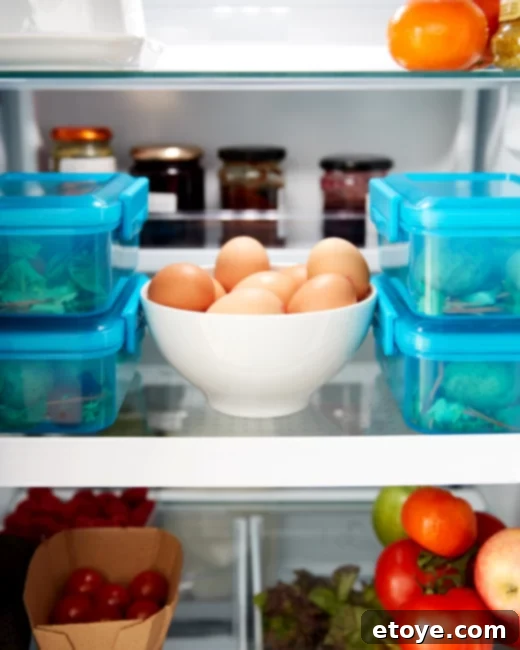Have you ever paused to consider if your current refrigerator organization habits are truly optimizing the freshness and safety of your food? Many households unknowingly compromise the longevity of their groceries simply by not understanding the ideal way to store different items. While you might not operate a bustling commercial kitchen, the scientific principles behind professional food storage are incredibly valuable and easily applicable to your home fridge. This comprehensive guide will demystify the art of refrigerator organization, showing you how to arrange every item for maximum freshness, safety, and a significant reduction in food waste.
Understanding the unique temperature zones within your refrigerator is the cornerstone of effective food preservation. Each area of your fridge maintains a distinct temperature profile, creating optimal environments for specific food types. By aligning your storage choices with these natural zones, you can drastically extend the shelf life of your ingredients, prevent spoilage, and ensure every meal is as delicious and safe as possible. Let’s embark on a journey to transform your fridge into an efficient powerhouse, ensuring you get the most out of every grocery trip.
Master Your Fridge: The Ultimate Guide to Optimal Food Storage and Freshness
Ready to revolutionize your kitchen and keep your food fresher for longer? This ultimate guide provides professional insights and practical tips for organizing your refrigerator, ensuring peak freshness, maximizing food safety, and dramatically reducing food waste. Discover the science-backed strategies behind optimal food storage and transform your home fridge into a model of efficiency and preservation.
The Refrigerator Doors: Your Warmest Zone
The doors of your refrigerator are, perhaps surprisingly, the warmest section. They are also subjected to the most frequent temperature fluctuations as you open and close the fridge throughout the day. This dynamic environment makes them unsuitable for highly perishable items that demand consistent cold, such as milk, eggs, or delicate dairy products. Instead, the fridge doors are perfectly suited for foods that inherently possess a higher tolerance for temperature shifts or contain natural preservatives. Think of these shelves as the dedicated home for your condiments and beverages.

What Belongs in the Doors:
- Condiments: Mustard, ketchup, mayonnaise, relish, hot sauces, salad dressings, and other jarred or bottled sauces are ideal. Their typical ingredients, like vinegar, salt, and sugar, contribute to their stability even with slight temperature variations.
- Jams and Jellies: Similar to condiments, fruit preserves benefit from the convenience and slightly warmer conditions of the door.
- Bottled Beverages: Water, soda, fruit juices (especially those high in sugar), and other packaged drinks are perfectly at home here.
- Butter: If you use butter frequently and prefer it softer for spreading, a dedicated butter compartment in the door can keep it at a more pliable temperature without significant risk, thanks to its high fat content.
Pro Tip for Door Organization and Food Safety: It’s easy for fridge doors to become a forgotten zone, harboring expired condiments and old sauces. Remember, these items are still perishable! Make it a routine to check expiration or “best by” dates during your weekly cleanup. Regularly purging old items not only prevents accidental ingestion of spoiled food but also frees up valuable space and enhances overall fridge hygiene. Don’t overlook cleaning these shelves, as drips and spills can often go unnoticed for extended periods.
The Top Shelf: Prime Real Estate for Ready-to-Eat Foods
Moving inwards and upwards within the main refrigerator compartment, the top shelf typically offers a consistent, albeit not the absolute coldest, temperature zone. This makes it the ideal location for foods that are already cooked and ready to eat, or items that require minimal preparation. This “ready-to-eat” principle is a cornerstone of commercial kitchen food safety, specifically designed to prevent cross-contamination, and it’s a practice every home cook should adopt.

What to Store on the Top Shelf:
- Cooked Meats and Leftovers: Always prioritize placing cooked foods, particularly meats and poultry, on the top shelf. This crucial placement completely eliminates the risk of harmful bacteria from raw juices dripping onto your prepared meals. Ensure all leftovers are stored in airtight, sealed containers to maintain freshness and prevent any odors from permeating other foods.
- Deli Meats: Sliced turkey, ham, roast beef, and other prepared deli products should be kept securely sealed on this shelf.
- Prepared Snacks: Items like hummus, pre-cut vegetables (if not in the crisper), fruit salads, and individual snack packs are perfect here.
- Ready-to-Eat Meals: Pre-made sandwiches, microwaveable meals, and any food that will not undergo further cooking before consumption.
- Baked Goods: Refrigerated bread loaves, tortillas, pastries, and cakes that require chilling.
- Drinks: While some beverages reside in the door, larger pitchers of iced tea, water, or specialty drinks can be stored here.
Crucial Tip: Preventing Cross-Contamination: Always cover or seal any food placed on the top shelf. Using clear, airtight containers not only protects your food from airborne contaminants and absorbing unwanted odors but also allows for easy visibility, helping you keep track of what you have and reducing forgotten leftovers. Opt for glass or high-quality BPA-free plastic containers for optimal food safety and freshness.
The Middle Shelf: Dairy Central and Everyday Staples
As you move deeper into the main body of the refrigerator, the temperature generally becomes colder and more consistently stable compared to the doors and upper shelves. The middle shelf, therefore, provides an excellent and reliable environment for many everyday staple items, particularly dairy products, which thrive in these consistent, cool conditions. This stable temperature is key to significantly extending their shelf life and preserving their quality.

What to Store on the Middle Shelf:
- Milk: Place milk cartons deep inside the main compartment of the fridge, rather than the door, to ensure it receives the most consistent and coldest temperature.
- Eggs: Despite the common practice of storing eggs in door trays, the middle shelf offers a much more stable and colder temperature, which is crucial for preventing spoilage and maintaining quality. Keep them in their original carton to shield them from absorbing other food odors and to prevent moisture loss.
- Yogurt and Sour Cream: These cultured dairy products are highly sensitive to temperature fluctuations and benefit immensely from the consistent cold of the middle shelf.
- Cheeses: Both hard and soft cheeses, once opened, should ideally be wrapped in parchment paper or specialized cheese wraps and then placed in a loosely sealed plastic bag or container. This method allows them to breathe while preventing drying out and molding.
- Butter and Cream Cheese: While butter can go in the door if used frequently, for longer storage or less frequent use, the middle shelf’s colder, more stable environment is preferable.
- Puddings and Desserts: Many desserts, such as cheesecakes, custards, and refrigerated puddings, require refrigeration and will maintain their quality best on this shelf.
Optimizing Dairy Freshness: The consistent cold of the middle shelf is paramount for dairy products. Always ensure all containers are properly sealed to prevent contamination and retain moisture. For artisanal cheeses, consider investing in specialized cheese storage bags or containers that regulate humidity, further extending their deliciousness and preventing premature spoilage.
The Bottom Shelf: The Designated Meat Locker
The bottom shelf is undeniably the coldest section of your refrigerator, with the exception of the crisper drawers directly below. This makes it the absolute best and safest place for storing raw meats, poultry, and seafood. This specific placement is critical for two overarching reasons: ensuring optimal temperature stability for highly perishable raw foods and, most importantly, preventing potentially dangerous cross-contamination throughout your fridge.

Why the Bottom Shelf is Crucial for Raw Foods:
- Optimal Cold Temperatures: Raw meats and seafood are highly susceptible to bacterial growth. They require the coldest, most stable temperatures to inhibit bacteria and preserve their quality effectively until they are cooked.
- Gravity and Cross-Contamination Prevention: Placing uncooked meats at the very bottom shelf is a critical food safety measure. It prevents any potential drips, leaks, or spills from raw meat juices from contaminating ready-to-eat foods or other ingredients stored on shelves above. Imagine raw chicken juices dripping onto your fresh produce or cooked leftovers – this is a major food safety hazard that can lead to foodborne illnesses. By containing raw items at the lowest level, you effectively safeguard the entire contents of your refrigerator.
What to Store on the Bottom Shelf:
- Uncooked Beef, Pork, and Lamb: This includes cuts like steaks, roasts, ground meat, and chops.
- Uncooked Poultry: Whole chickens, turkeys, chicken breasts, thighs, and other poultry parts.
- Seafood: Fresh fish fillets, shrimp, scallops, mussels, and other raw seafood.
Essential Food Safety Practices: Always keep raw meats, poultry, and seafood in their original, sealed packaging. For an extra layer of protection and peace of mind, place these packages on a plate or in a shallow, rimmed container to catch any unforeseen leaks or drips. This simple yet vital step can save you from extensive cleaning and the potential waste of contaminated food. When defrosting frozen meats, always do so slowly in the refrigerator, ensuring they remain on the bottom shelf, never at room temperature, to maintain the highest food safety standards.
The Crisper Drawers: Your Produce Preservers
The lower drawers in your refrigerator, commonly known as crisper drawers, are specifically engineered microclimates designed to extend the life of your fresh fruits and vegetables. They typically operate at slightly different humidity levels than the main compartments, a crucial feature for preventing produce from wilting, shriveling, or rotting prematurely. However, simply tossing all your produce into one drawer isn’t the most effective strategy; strategic separation is key.

Understanding Crisper Zones for Optimal Storage:
Most modern refrigerators come equipped with two crisper drawers, often featuring adjustable humidity sliders. The secret to maximizing their potential lies in separating ethylene-producing fruits from ethylene-sensitive vegetables. Ethylene gas, a natural plant hormone, accelerates the ripening process and can cause premature spoilage in susceptible produce.
- High-Humidity Drawer (Slider Closed): This environment is ideal for leafy greens (like lettuce, spinach, kale, and Swiss chard), carrots, broccoli, cauliflower, cucumbers, fresh herbs, and other vegetables that benefit from moisture to stay crisp and hydrated. For delicate greens, wrapping them loosely in a damp paper towel before storage can significantly extend their freshness.
- Low-Humidity Drawer (Slider Open): This drawer is best reserved for ethylene-producing fruits and some vegetables that prefer less humidity, preventing excess moisture buildup that can lead to rot.
Ethylene-Producing Fruits (Store Separately):
These fruits should ideally be stored in their own low-humidity drawer to prevent them from prematurely ripening (and potentially spoiling) other produce. Some of these can even be stored on the counter until they reach desired ripeness, then moved to the fridge to slow down further ripening.
- Apples
- Bananas (unripe)
- Pears
- Peaches
- Melons (cantaloupe, honeydew, watermelon)
- Kiwi
- Apricots
- Tomatoes (best stored on the counter until fully ripe, then moved to the fridge)
- Avocados (unripe on counter, ripe in fridge)
- Plums
- Bell Peppers
Ethylene-Sensitive Vegetables (Store Apart from Ethylene Producers):
These vegetables will wilt, yellow, and spoil much faster if exposed to ethylene gas from ripening fruits.
- Lettuce and most leafy greens
- Broccoli
- Cauliflower
- Carrots
- Cucumbers
- Green beans
- Eggplant
- Asparagus
- Potatoes (best stored in a cool, dark pantry, not the fridge)
Produce Preparation and Storage Tips for Longevity:
- Washing Timing: While it’s imperative to wash all fruits and vegetables thoroughly before consumption, avoid washing them too far in advance of eating or cooking. Excess moisture can actively encourage bacterial growth and accelerate spoilage. Wash them right before you’re ready to use them.
- Provide Breathing Room: Resist the urge to overcrowd your crisper drawers. Proper air circulation is absolutely vital for maintaining freshness and preventing premature spoilage.
- Freezing for Future Use: For produce nearing its peak or if you’ve bought items in bulk, freezing is an excellent method to suspend their freshness for later use in smoothies, soups, sauces, or baking. Remember to blanch most vegetables before freezing to preserve their color, texture, and nutritional value.
- Berry Best Practices: Store unwashed berries in a single layer in a shallow container lined with a paper towel. A quick rinse in a diluted vinegar-water solution (1 part vinegar to 3 parts water), followed by thorough drying, can also help inhibit mold growth and extend their shelf life.
Beyond Organization: Essential Fridge Maintenance for Longevity and Safety
While strategic organization is a powerful step, it’s just one component of a holistic approach to maximizing food freshness and ensuring safety. Regular maintenance and adopting smart daily habits are equally critical to a well-functioning and hygienic refrigerator:
- Maintain Optimal Temperature: Crucially, ensure your refrigerator is consistently set to the correct temperature range, ideally between 35°F (1.7°C) and 40°F (4.4°C). Using an independent fridge thermometer is highly recommended, as your appliance’s built-in thermostat can sometimes be inaccurate. This temperature range is vital for slowing bacterial growth.
- Prioritize Cleanliness: Make it a habit to regularly clean your fridge shelves, walls, and drawers. Spills, crumbs, and forgotten items can harbor bacteria and lead to unpleasant odors. A thorough deep clean every few months, where you empty and wipe down all surfaces with a mild soap and water solution, is highly recommended.
- Avoid Overfilling: It’s tempting to cram every grocery item into your fridge, but an overpacked refrigerator restricts vital airflow. Restricted airflow prevents consistent cooling, forcing your appliance to work harder and potentially creating warmer spots where food can spoil faster. Allow sufficient space for air to circulate freely around all items.
- Implement FIFO (First-In, First-Out): Adopt the “First-In, First-Out” method. When putting away new groceries, always move older items of the same type to the front of the shelf so they are used first. This simple yet effective habit dramatically reduces food waste and ensures you’re consuming food within its peak freshness window.
- Invest in Quality Airtight Containers: A good set of airtight, food-grade containers is an indispensable asset. They are essential for preventing spoilage, keeping strong odors contained, and optimizing vertical space within your fridge. Clear containers also help you quickly identify contents.
- Diligently Check Expiration Dates: Make it a regular habit to check expiration and “best by” dates on all packaged foods, particularly during your weekly grocery put-away or when planning meals. Discard anything past its prime promptly to prevent contamination or accidental consumption.
Congratulations! By diligently implementing these professional strategies, you’re not just storing food; you’re actively preserving its quality, significantly extending its life, and upholding the highest standards of food safety in your home kitchen. You’ve officially graduated to Fridge Storage Master level! Go forth, organize with confidence, and enjoy a fresher, more efficient, and wonderfully less wasteful culinary journey. Share these valuable insights with friends and family to spread the word of superior fridge safety and lasting food longevity!
